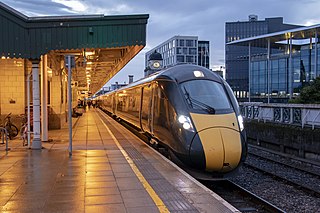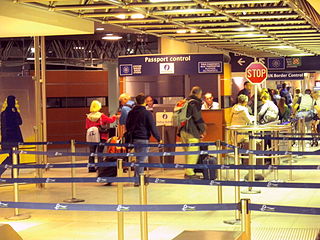Related Research Articles

Transport in Belgium is facilitated with well-developed road, air, rail and water networks. The rail network has 2,950 km (1,830 mi) of electrified tracks. There are 118,414 km (73,579 mi) of roads, among which there are 1,747 km (1,086 mi) of motorways, 13,892 km (8,632 mi) of main roads and 102,775 km (63,861 mi) of other paved roads. There is also a well-developed urban rail network in Brussels, Antwerp, Ghent and Charleroi. The ports of Antwerp and Bruges-Zeebrugge are two of the biggest seaports in Europe. Brussels Airport is Belgium's biggest airport.
Gibraltar has a limited public transport system, due to the compact size of the territory.

Hong Kong has a highly developed and sophisticated transport network, encompassing both public and private transport. Based on Hong Kong Government's Travel Characteristics Survey, over 90% of daily journeys are on public transport, the highest rate in the world. However, in 2014 the Transport Advisory Committee, which advises the Government on transportation issues, issued a report on the much-worsened congestion problem in Hong Kong and pointed at the excessive growth of private cars during the past 10–15 years.

Transport in Macau includes road, sea, rail and air transport. Road transport is the primary mode of transport within Macau, although a new rail system opened in December 2019 serving the areas of Taipa and Cotai. The main forms of public transport are buses and taxis.

Border control refers to measures taken by governments to monitor and regulate the movement of people, animals, and goods across land, air, and maritime borders. While border control is typically associated with international borders, it also encompasses controls imposed on internal borders within a single state.

Hong Kong International Airport is a major international airport and the primary airport serving Hong Kong. It is built on reclaimed land on the island of Chek Lap Kok, Hong Kong. The airport is also referred to as Chek Lap Kok International Airport or Chek Lap Kok Airport, to distinguish it from its predecessor, the former Kai Tak Airport.

A border checkpoint is a location on an international border where travelers or goods are inspected and allowed passage through. Authorization often is required to enter a country through its borders. Access-controlled borders often have a limited number of checkpoints where they can be crossed without legal sanctions. Arrangements or treaties may be formed to allow or mandate less restrained crossings. Land border checkpoints can be contrasted with the customs and immigration facilities at seaports, international airports, and other ports of entry.

Merseyrail is a commuter rail network serving the Liverpool City Region and adjacent areas of Cheshire and Lancashire. Merseyrail operates 66 railway stations across two lines – the Northern Line and the Wirral Line, which are dedicated 750 V DC third rail electrified lines converging into rapid transit-style underground sections in the centres of Liverpool and Birkenhead. Merseyrail branding is also applied to stations and ticketing on the City Line, which are within the Liverpool City Region but operated by other train operating companies, predominantly Northern Trains. The City Line services operate on the Liverpool to Manchester Lines and the Liverpool to Wigan Line using a mix of AC electric and diesel trains.

Rosslare Europort is a modern seaport located at Rosslare Harbour in County Wexford, Ireland, near the southeasternmost point of the island of Ireland. The port is the premier Irish port serving the European Continent with 36 direct services to the Continent weekly. It handles passenger and freight ferries to and from Cherbourg, Dunkirk and St Malo/Roscoff, in France, Bilbao in Spain and Fishguard and Pembroke Dock in the United Kingdom. Since July 2022, a new freight route between Rosslare and Zeebrugge, Belgium was introduced by Finnlines for a twice weekly ro-ro service between the two ports.

Preclearance is the United States Department of Homeland Security's (DHS) practice of operating prescreening border control facilities at airports and other ports of departure located outside of the United States pursuant to agreements between the United States and host countries. Travelers are subject to immigration and customs inspections by Customs and Border Protection (CBP) officers before boarding their transportation onward to the United States. Preclearance applies to all passengers regardless of their nationality or purpose of travel. Upon arrival, precleared passengers arrive in the United States as domestic travelers, but may still be subject to re-inspection at the discretion of CBP. This process is intended to streamline border procedures, reduce congestion at American ports of entry, and facilitate travel into airports that otherwise lack immigration and customs processing facilities for commercial flights.

Transport in Wales is heavily influenced by the country's geography. Wales is predominantly hilly or mountainous, and the main settlements lie on the coasts of north and south Wales, while mid Wales and west Wales are lightly populated. The main transport corridors are east–west routes, many continuing eastwards into England.
The transport system in Scotland is generally well-developed. The Scottish Parliament has control over most elements of transport policy within Scotland, with the Cabinet Secretary for Transport, Infrastructure and Connectivity holding portfolio responsibility within the Scottish Government. Transport Scotland is the Executive Agency responsible for the Scottish transport network.
Airline reservation systems (ARS) are systems that allow an airline to sell their inventory (seats). It contains information on schedules and fares and contains a database of reservations and of tickets issued. ARSs are part of passenger service systems (PSS), which are applications supporting the direct contact with the passenger.

The UK Border Agency (UKBA) was the border control agency of the Government of the United Kingdom and part of the Home Office that was superseded by UK Visas and Immigration, Border Force and Immigration Enforcement in April 2013. It was formed as an executive agency on 1 April 2008 by a merger of the Border and Immigration Agency (BIA), UKvisas and the detection functions of HM Revenue and Customs. The decision to create a single border control organisation was taken following a Cabinet Office report.

Heathrow Worldwide Distribution Centre (HWDC) is a sorting office for inbound and outbound international mail operated by Royal Mail. Located close to Heathrow Airport, the HWDC is situated in the town of Langley, Berkshire, near Slough, and began operations in 2003. The centre is often referred to by its abbreviation, Langley HWDC, or as 'GBLALA' in mail tracking information.
Until 2019, Customs Handling of Import & Export Freight (CHIEF) is the computer system of the United Kingdom's revenue and customs services, HMRC, used for managing the declaration and movement of goods into and out of the United Kingdom and allowing UK traders to communicate with counterpart customs systems in the other member states of the European Union. It also managed movement of goods across EU borders where the moved material belonged to a UK party. It has been partly replaced by the Customs Declaration Service (CDS). CHIEF is due to be retired during 2022.
e-Borders was an advance passenger information programme which aimed to collect and store information on passengers and crew entering and leaving the United Kingdom. Passengers details were to be checked against terror and criminal watch lists before being stored on the e-borders database. Due to European law on free movement EU carriers and ports supply information to the UK Border Agency on a voluntary basis; however in March 2012 Damian Green said that by April e-Borders would be collecting information on all passengers on 100% of non-EEA flights to the UK. The information of the passengers and crew was to be collected by the airline, train operating company, ferry and other carriers and ports and is then passed on to the e-Borders programme via the Carrier Gateway provided by Serco. In 2014 it was announced that the system would be scrapped.

Juxtaposed controls are a reciprocal arrangement between Belgium, France, the Netherlands and the United Kingdom whereby border controls on certain cross-Channel routes take place before boarding the train or ferry, rather than upon arrival after disembarkation. With the exception of the Eurotunnel Shuttle route, customs checks remain unaffected by juxtaposed immigration controls and continue to take place upon arrival after disembarkation. Belgium, France and the Netherlands are all member states of the European Union and part of the border-free Schengen Area. The United Kingdom, on the other hand, has never participated in the Schengen Area, even when it was a member state of the European Union. As a result, juxtaposed controls aim to increase the convenience and efficiency of border checks when travelling by train or ferry between the Schengen Area and the UK by removing the need for immigration checks on arrival and by streamlining checks on departure. At the same time, juxtaposed controls are intended to detect and prevent illegal immigration. In 2016, there were over 56,000 instances when people were refused entry to the UK at the juxtaposed controls.

ePassport gates are automated self-service barriers operated by the UK Border Force and located at immigration checkpoints in arrival halls in some airports across the UK and at the juxtaposed controls in international railway terminals abroad, offering an alternative to using desks staffed by immigration officers. The gates use facial recognition technology to verify the traveller's identity against the data stored in the chip in their biometric passport, as well as run the data against numerous databases to determine if the traveller is a security risk.
Connect is a new social network analysis software data mining computer system developed by HMRC (UK) that cross-references business's and people's tax records with other databases to establish fraudulent or undisclosed (misdirected) activity.
References
- ↑ Project Semaphore
- ↑ Report
- ↑ Visit in April 2011
- ↑ "- Port of Dover". www.doverport.co.uk. Retrieved 14 April 2018.